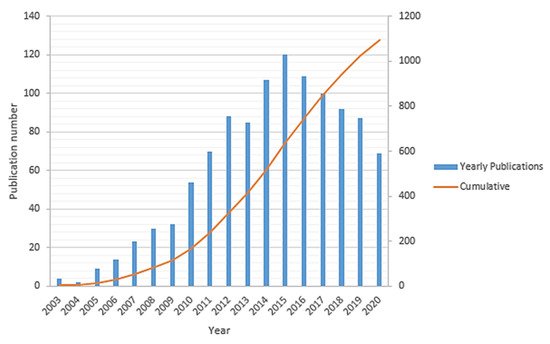An effective approach to improving the proton conductivity of PEMs is to incorporate some additional components. Composite membranes showed promising potential to be used as HT-PEMFCs. Composite materials consist of two or more constituents with different chemical, mechanical, or physical properties
[59]. Composite membranes have widely been used in PEMFCs such as PTFE/Nafion
[59], metal-oxide-recast/Nafion
[60], copper phthalocyanine tetrasulfonic acid tetrasodium salt (CuTSPc)/Nafion
[61], calcium titanate/PBI
[62], PBI-SiO
2 [63], Nafion
®/SiO
2 [64], polyvinylidene fluoride (PVDF)/Nafion
[65], Nafion/polyaniline
[66], PBI/graphene oxide
[24], etc. Fillers can provide additional chemical resistance, mechanical strength, and proton conductivity. Hydrophilic fillers improve membrane water uptake, and thereby, they can be used in low RH environments
[59]. Inorganic fillers have high mechanical strength, thermal stability, and water-absorbing capacity and can be used in low RH and/or at elevated temperatures. The change in H
2 crossover and proton conductivity at different operating conditions with/without filler in Nafion is illustrated in
Figure 3. As shown in
Figure 3a, the channels within the membrane are fully saturated with water and the mechanisms for proton conduction can be either “Grotthus” or diffusion. In this case, open-circuit voltage (OCV) can be reduced due to the molecular H
2 passing through the membrane (H
2 crossover). At higher temperatures (
Figure 3b), water begins evaporation and results in the shrinkage of the channels and decreasing proton conductivity. On the other hand, H
2 crossover improves at elevated temperatures. Adding filler to the composite (
Figure 3c) can decrease H
2 crossover and increase H
2 path to migrate from anode to cathode
[59].
Different types of fillers have been used for improving the PEMs performance. Ceria is a filler that can diminish membrane degradation by acting as a regenerative free-radical scavenger
[67]. Hydrophilic fillers can absorb a large quantity of water and improve proton conductivity and alleviate the unfavourable effect of high temperatures
[60]. Although silica nanoparticles are hydrophobic, it has been reported that they do not have any negative effect on membrane water uptake
[68]. Dispersion of sulphonated zirconia in the Nafion matrix can also improve the proton conductivity by functionalizing the Zr with sulphonic groups. Proton conductivity of about 3 × 10
−3 S.cm
−1 at 120 °C and under anhydrous conditions has been reported for this PEM composite
[69]. Although increasing water uptake is favourable, excessive water uptake may negatively affect performance
[70]. Graphene oxide is a hydrophilic material with lots of oxygen-containing functional groups and has recently been used as fillers in PEMFCs
[71]. It has been reported that graphene oxide (GO) composite membranes can extend the operating temperature because they can retain more water and increase the proton conductivity
[24][59].
Mixed-matrix membranes (MMMs) are a class of membranes comprised of a solid phase uniformly distributed in a polymer matrix. MMMs benefit from the advantages of the polymer membrane (high flexibility and ion exchange capacity) and inorganic constituents (high thermal and mechanical properties, water uptake, and proton conductivity)
[72]. Among the inorganic materials, metal-organic frameworks such as Fe, Cr, Al, and Zr have high specific surface areas and offer higher proton conductivity. These MOFs can improve proton conductivity by defect engineering, postsynthetic modification, and impregnation with acidic molecules
[73]. Amongst various forms of the applied MOFs, chromium terephthalate such as MIL-101(Cr) (MIL stands for Materials of Institute Lavoisier) with the chemical formula of {Cr
3F(H
2O)
2O(BDC)
3.nH
2O} (n~25; 1,4-benzenedicarboxylate (BDC) showed higher conductivity than the other types. This material can easily be functionalized with excellent chemical/hydrothermal stability and is strongly resistant against moisture and organic molecules
[74]. High proton conductivity of about 4.1 × 10
−2 S.c006D
−1 at 160 °C and RH = 0% has been reported by Anahidzade et al.
[75], who fabricated MIL-101 (Cr) by hydrothermal method followed by functionalizing it via the postgrafting route. However, restricted proton transportation caused by the grain boundary of MOFs resulted in decreasing the proton conductivity
[76]. To overcome this issue, MOFs hybridization with other polymers can alleviate the low proton conductivity
[77]. UiO-series (UiO stands for the University of Oslo) MOFs are another class of MOFs that has attracted considerable interest because of their high energy conversion rate and low operating temperatures. These materials mainly contain Zr and have excellent chemical and thermal stability due to the highly oxyphilic Zr (IV) atoms
[78][79]. In this context, Rao et al.
[78] fabricated Nafion/GO@UiO-66-SO
3H composites with a high conductivity of about 3.03 × 10
−1 S.cm
−1 at 90 °C and RH = 95%. They reported that consecutive proton transfer channels were constructed within the PEM composite due to the suitable interconnection of MOF grains and the tethering effect of GO surfaces. It has been reported that UiO-66 possesses a very poor proton conductivity of about 7 × 10
−6. However, sulphonated UiO-66 (UiO-66-SO
3H) has super protonic conductivity (four orders of magnitude greater than the UiO-66)
[80][81][82]. The synergic effect between UiO-66-SO
3H and Uio-66-NH
2 was found to have a great effect on the proton conductivity of the composite
[83]. Other types of MOFs such as zeolite imidazolate frameworks (ZIFs)
[84], a chiral 2-D MOF named “MOF 1”
[85], which combined protic ionic liquids (PILs) with porous MOFs
[86], etc., have also been investigated. Overall, MOFs-modified PEMFCs have shown promising electrochemical performance at high temperatures and anhydrous conditions. MIL class can promote proton conductivity using the abundant hydroxyl groups. The UiO class possesses a high-density spatial structure with strong chemical stability. Selecting the appropriate composite, suitable dispersion condition, and the MOF concentration is the most critical factor affecting the composites’ conductivity and physiochemical/thermal stability.



